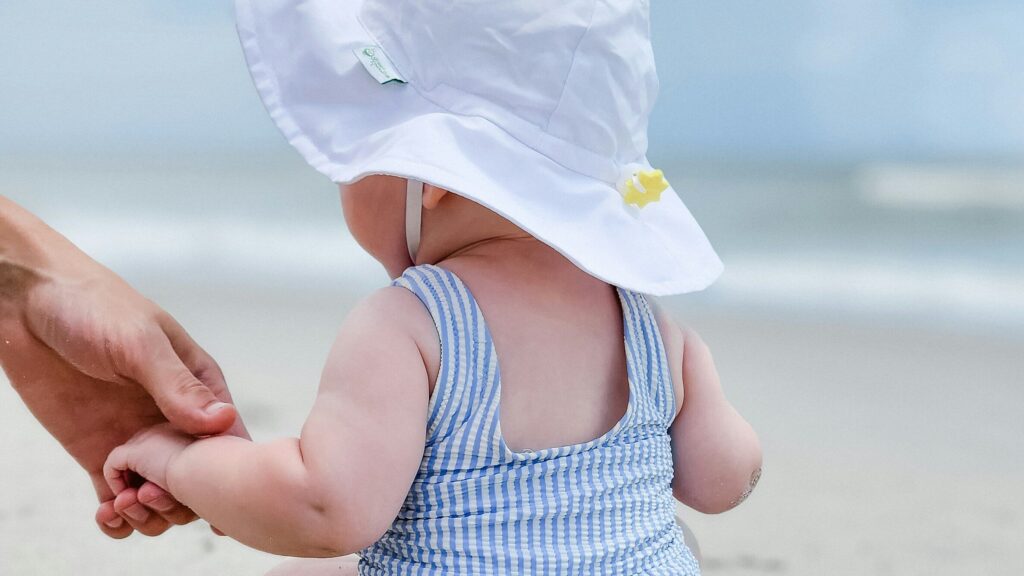Babies under 6 months should stay out of direct sunlight. The FDA and American Academy of Pediatrics both say this. Sunscreen is not usually suggested for young babies.
Their skin is very sensitive and can react fast. If you cannot find shade, talk to your pediatrician. You can ask about using a little mineral sunscreen on bare skin.
Dress your baby in light clothes and a wide brimmed hat. Try to keep your baby out of the sun from 10 a.m. to 2 p.m. These tips help you feel better about keeping your baby safe in the sun.
Key Takeaways
- Babies younger than 6 months should not be in direct sunlight. Do not use sunscreen on them. Use shade, hats, and light clothes to protect them.
- Babies older than 6 months can use mineral based sunscreen. Pick one with SPF 30 or higher. Make sure it has broad spectrum protection. This helps stop sunburn.
- Put sunscreen on all skin that is not covered. Do this 15 to 30 minutes before going outside. Put more on every two hours or after swimming.
- Dress your baby in UV protective clothes and wide hats. Keep them in the shade during the sun’s strongest hours, from 10 a.m. to 2 p.m.
- Pick mineral sunscreens that are fragrance free and water resistant. Look for zinc oxide or titanium dioxide in the ingredients. These give safe and strong sun protection.
Babies Need Sunscreen?
Under 6 Months
You might wonder if babies need sunscreen when they are so little. For infants under 6 months, the answer is almost always no.
Medical experts, including the American Academy of Pediatrics, say you should keep your baby out of direct sunlight. Their skin is much thinner and more sensitive than yours.
Sun exposure at this age can cause serious problems. Babies can get sunburned quickly, even on cloudy days. Sunburn in early life increases the risk of skin cancer, DNA damage, and even weakens the skin’s immune system. Just one bad sunburn as a baby can double the risk of melanoma later in life.
Tip: Instead of sunscreen, use shade, hats, and lightweight clothing to protect your baby. A stroller canopy or umbrella works well. If you cannot avoid the sun, you can ask your pediatrician about using a small amount of mineral sunscreen on tiny exposed areas like the cheeks or backs of the hands. Always choose a fragrance free, high SPF formula if you must use it.
Sunscreen is not the best choice for babies under 6 months because their skin absorbs chemicals more easily. This can lead to irritation or allergic reactions. Their bodies are small, so even a little sunscreen can have a big effect.
That is why experts say to avoid sunscreen and focus on physical barriers. Vitamin D is important, but you do not need to put your baby in the sun for this. Supplements are safer and recommended by doctors.
Over 6 Months
Once your baby turns 6 months old, the rules change. Now, babies need sunscreen if they will be outside and you cannot keep them in the shade.
Their skin is still sensitive, but it is a bit stronger than before. Studies show that sunscreen use in babies over 6 months helps prevent sunburn and long term skin damage.
Dermatologists and pediatricians recommend using a broad spectrum sunscreen with SPF 30 or higher. This protects against both UVA and UVB rays.
Here is what you should look for when choosing sunscreen for your baby:
- Mineral (physical) sunscreens with zinc oxide or titanium dioxide
- Broad spectrum protection (UVA and UVB)
- SPF 30 or higher
- Water resistant formulas
- Fragrance free and hypoallergenic options
| Feature | Why It Matters for Babies Over 6 Months |
|---|---|
| Mineral Ingredients | Less likely to irritate sensitive skin |
| Broad Spectrum | Shields from both UVA and UVB rays |
| SPF 30+ | Offers strong protection against sunburn |
| Water Resistant | Stays on during play or swimming |
| Fragrance Free | Reduces risk of allergic reactions |
You may notice that mineral sunscreens sometimes leave a white film. This is normal and shows the sunscreen is sitting on top of the skin, blocking the sun. Some brands offer tinted or micronized versions to help with this.
Note: Babies need sunscreen even on cloudy days. UV rays can pass through clouds and cause sunburn. Darker skin still needs protection, too. Sunscreen should be the last step after shade and clothing, not the only step.
Many parents think one application is enough, but sunscreen must be reapplied every two hours, especially after swimming or sweating. Cream based sunscreens work best for full coverage. Spray sunscreens can miss spots and should be rubbed in well.
Babies need sunscreen as part of a bigger sun safety plan. Along with sunscreen, use hats, long sleeves, and try to stay out of the sun during peak hours (10 a.m. to 2 p.m.).
These habits help protect your child’s skin now and in the future. Early sun protection lowers the risk of skin cancer, sunburn, and premature aging.
Choosing Sunscreen
Mineral vs. Chemical
When you pick sunscreen for your baby, you have two main choices. There are mineral sunscreens and chemical sunscreens.
Mineral sunscreens use zinc oxide or titanium dioxide. These sit on top of the skin and block UV rays right away. Chemical sunscreens work in a different way. They soak into the skin and turn UV rays into heat. Some chemical filters, like oxybenzone, can enter the bloodstream. Experts have not found clear harm, but they still say to be careful with babies.
You should pick mineral sunscreens for your baby. They are less likely to bother the skin and are safe for sensitive skin. Health groups around the world say zinc oxide and titanium dioxide are safe for babies. Mineral sunscreens also start working right after you put them on. You do not have to wait for them to work.
Tip: Mineral sunscreens are sometimes called “physical” sunscreens. Look for these words on the bottle.
SPF and Broad Spectrum
SPF means Sun Protection Factor. For babies older than six months, experts say to use SPF 30 or more. This blocks about 97% of harmful rays. You should also check for “broad spectrum” on the label.
Broad spectrum sunscreens protect against both UVA and UVB rays. UVA rays can hurt the deeper layers of skin and raise the risk of skin cancer. UVB rays cause sunburn. Both can damage your baby’s skin.
A good baby sunscreen should be:
- SPF 30 or higher
- Broad spectrum
- Water resistant
- Fragrance free
Safe Ingredients
You want to keep your baby’s skin safe. The FDA says only zinc oxide and titanium dioxide are “generally recognized as safe and effective” for babies.
These ingredients stay on the skin’s surface and do not get absorbed. They are gentle and work well for sensitive skin. Stay away from chemical ingredients like oxybenzone and octinoxate. These can get into the body and may cause allergies or other problems, especially for babies.
Note: Always check the label for “non nano” mineral ingredients. This means the particles are not small enough to go into the skin. Stick with simple, mineral based formulas for the safest sun protection.
Applying Sunscreen
How Much to Use
You might wonder how much sunscreen your baby needs for good protection. For babies over six months, a generous amount works best. Experts suggest using about one ounce of sunscreen for full body coverage.
This is about the size of a small medicine cup or a shot glass. Most people use less than this, which means the sunscreen does not work as well as it should. If you use too little, your baby’s skin may not get enough protection from the sun’s rays.
Make sure you cover all exposed areas. Do not forget easy to miss spots like the ears, the tops of the feet, and the backs of the hands.
Apply sunscreen evenly to every area that sunlight can reach. You should put sunscreen on your baby’s skin 15 to 30 minutes before going outside. This gives the sunscreen time to form a protective layer.
Tip: Sunscreen works best when you use enough and spread it out evenly. Missing spots or using too little can lower the level of UV protection your baby gets.
When to Reapply
Sunscreen does not last all day, especially when your baby plays, sweats, or gets wet. You need to reapply sunscreen at least every two hours.
If your baby swims, sweats, or you towel them off, put on more sunscreen right away. Water-resistant sunscreens usually last between 40 and 80 minutes, so check the label for details.
Dermatologists say that sunscreen wears off faster with water or sweat. Even on cloudy days, UV rays can reach your baby’s skin, so reapplying is important. Keeping up with reapplication helps maintain strong protection and lowers the risk of sunburn.
Note: Frequent reapplication is key for safe outdoor play. Sunscreen only works if you keep it on your baby’s skin.
More Sun Protection
Clothing and Hats
You can do a lot to protect your baby from the sun just by choosing the right clothes. Not all fabrics block UV rays the same way. Regular cotton T shirts only give a little protection, about UPF 15.
You want more than that for your baby’s delicate skin. Look for UV resistant clothing with a UPF rating of 40 or 50+. These clothes block over 98% of harmful rays and feel soft and breathable.
Some of the best fabrics mix bamboo, organic cotton, and elastane. They keep your baby cool and safe without using extra chemicals.
Here are some clothing options that offer strong sun protection:
- Baby suits and playsuits
- Onesies and ponchos
- UV blankets and multifunctional cloths
- Baby beanies and wide brimmed sun hats
Swim time?
You can use lycrasuits, swim shirts, and tankinis made for UV protection. These cover more skin and help prevent burns, even in the water.
Tip: Always pick hats with a wide brim or a legionnaire style flap. These hats shade your baby’s face, ears, and neck. Studies show that children who wear hats get fewer sun spots and less sun damage on their heads and necks.
| Clothing Type | Sun Protection Benefit |
|---|---|
| UV suits/onesies | Full body coverage, UPF 50+ |
| Sun hats | Shields face, ears, and neck |
| Swim shirts/lycrasuits | Protects during water play |
Shade and Timing
You can lower your baby’s sun risk by planning when and where you go outside. The sun’s rays are strongest between 10 a.m. and 4 p.m.
Try to keep your baby in the shade during these hours. Trees, umbrellas, and stroller canopies all help block direct sunlight. Even on cloudy days, UV rays can reach your baby, so shade is always a smart choice.
- Keep babies under six months out of direct sunlight as much as possible.
- Use shade from trees, umbrellas, or a stroller canopy.
- Plan outdoor time before 10 a.m. or after 4 p.m. when the sun is less intense.
- Dress your baby in lightweight, long-sleeved clothing and a hat for extra coverage.
Experts say shade works better than sunscreen alone, especially for babies. Sunscreen should be your backup, not your main plan. UV rays can bounce off sand, water, and even concrete, so use a mix of shade, clothing, and hats for the best protection.
Note: You can check the daily UV index to know when extra protection is needed. Even if you find a shady spot, keep your baby covered and cool for the safest sun experience.
You now know when babies need sunscreen and how to pick the safest kind. Choose mineral sunscreens with zinc oxide or titanium dioxide and SPF 30 to 50.
Dress your baby in sun protective clothing, hats, and sunglasses. Combine sunscreen with shade and avoid peak sun hours. If you have questions or your baby has sensitive skin, talk to your pediatrician. Simple steps help keep your little one safe and happy in the sun.
FAQ
What should you do if your baby gets sunburned?
If your baby gets sunburned, move them out of the sun right away. Cool their skin with a damp cloth. Offer extra fluids. Call your pediatrician for advice. Avoid using creams or lotions unless your doctor says it’s okay.
What is the best way to test sunscreen on your baby?
You can test sunscreen by applying a small amount to a patch of your baby’s skin, like the inside of their arm. Wait 24 hours. If you see redness or a rash, do not use that sunscreen.
What makes mineral sunscreen safer for babies?
Mineral sunscreen sits on top of your baby’s skin and blocks UV rays. It uses zinc oxide or titanium dioxide. These ingredients do not soak into the skin. They are less likely to cause irritation or allergic reactions.
What should you do if sunscreen gets in your baby’s eyes?
Rinse your baby’s eyes with cool water right away. Gently pat the area dry. Watch for redness or discomfort. If your baby keeps rubbing their eyes or seems in pain, call your doctor for help.



